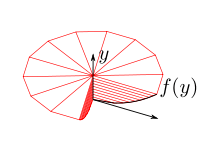Disc integration

| Part of a series of articles about | ||||||
| Calculus | ||||||
|---|---|---|---|---|---|---|
|
||||||
|
Specialized |
||||||
Disc integration, also known in integral calculus as the disc method, is a means of calculating the volume of a solid of revolution of a solid-state material when integrating along the axis of revolution. This method models the resulting three-dimensional shape as a stack of an infinite number of discs of varying radius and infinitesimal thickness. It is also possible to use the same principles with rings instead of discs (the "washer method") to obtain hollow solids of revolutions.
Definition
Function of x
If the function to be revolved is a function of x, the following integral represents the volume of the solid of revolution:
where R(x) is the distance between the function and the axis of rotation. This works only if the axis of rotation is horizontal (example: y = 3 or some other constant).
Function of y
If the function to be revolved is a function of y, the following integral will obtain the volume of the solid of revolution:
where R(y) is the distance between the function and the axis of rotation. This works only if the axis of rotation is vertical (example: x = 4 or some other constant).
Washer method
To obtain a hollow solid of revolution (the “washer method”), the procedure would be to take the volume of the inner solid of revolution and subtract it from the volume of the outer solid of revolution. This can be calculated in a single integral similar to the following:
where RO(x) is the function that is farthest from the axis of rotation and RI(x) is the function that is closest to the axis of rotation. One should take caution not to evaluate the square of the difference of the two functions, but to evaluate the difference of the squares of the two functions.
(This formula only works for revolutions about the x-axis.)
To rotate about any horizontal axis, simply subtract from that axis each formula. If h is the value of a horizontal axis, then the volume equals
For example, to rotate the region between y = −2x + x2 and y = x along the axis y = 4, one would integrate as follows:
The bounds of integration are the zeros of the first equation minus the second. Note that when integrating along an axis other than the x, the further axis may not be that obvious. In the previous example, even though y = x is further up than y = −2x + x2, it is the inner axis since it is closer to y = 4
The same idea can be applied to both the y-axis and any other vertical axis. One simply must solve each equation for x before one inserts them into the integration formula.
See also
References
- "Volumes of Solids of Revolution". CliffsNotes.com. Retrieved July 8, 2014.
- Weisstein, Eric W. "Method of Disks". MathWorld. Retrieved July 12, 2013.
- Frank Ayres, Elliott Mendelson. Schaum's Outlines: Calculus. McGraw-Hill Professional 2008, ISBN 978-0-07-150861-2. pp. 244–248 (online copy, p. 244, at Google Books. Retrieved July 12, 2013.)